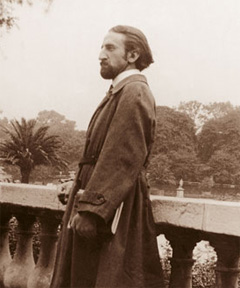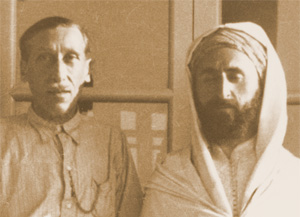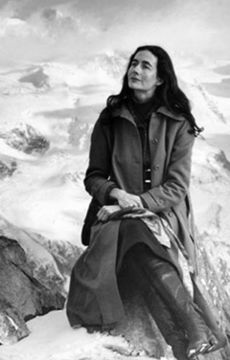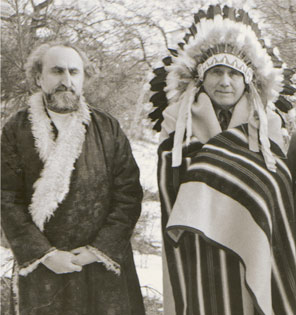Frithjof Schuon facts for kids
Quick facts for kids
Frithjof Schuon
|
|
|---|---|
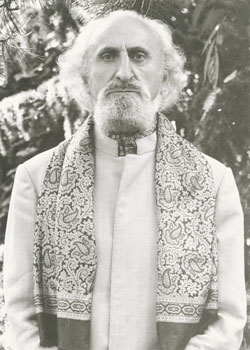
Frithjof Schuon, c. 1980
|
|
| Born | 18 June 1907 |
| Died | 5 May 1998 (aged 90) Bloomington, Indiana, U.S.A.
|
| Nationality |
|
|
Notable work
|
|
| School | Perennial philosophy Traditionalist School |
|
Main interests
|
Metaphysics, esoterism, philosophy, spirituality, religion, art |
|
Influences
|
|
|
Influenced
|
|
| Signature | |
Frithjof Schuon (born June 18, 1907 – died May 5, 1998) was a Swiss thinker of German background. He was part of a group of philosophers called the Traditionalist School. This group believed in a "Perennial Philosophy," which means that all major religions share a common, timeless truth.
Schuon wrote over twenty books in French. These books explored big ideas about life, spirituality, and different religions. His works have been translated into many languages. Besides writing, he was also a talented painter and poet.
Along with other important thinkers like René Guénon, Schuon was a key figure in the 20th century who spoke about the "perennial philosophy." He believed that there is one absolute truth, which people often call God. He taught that all religions, even with their differences, point to this same truth. He also thought that humans can understand deep spiritual knowledge. He often criticized modern society for losing touch with its spiritual roots.
Schuon was interested in Sufism, a spiritual path within Islam. He founded his own Sufi group called the Tarīqa Maryamiyya. His writings often talked about how universal spiritual truths are. He also stressed the importance of living a good life and appreciating beauty.
He made friends with many people from different religious backgrounds. He was especially interested in the traditions of the North American Plains Indians. He became good friends with some of their leaders. He was even adopted into both a Lakota Sioux tribe and the Crow tribe. Schuon lived in France and Switzerland for most of his life. When he was 73, he moved to the United States.
Life and Early Years
Growing Up in Switzerland (1907–1920)
Frithjof Schuon was born in Basel, Switzerland, on June 18, 1907. His father, Paul Schuon, was German, and his mother, Margarete Boehler, was French-speaking. His father was a concert violinist, so their home was full of music, books, and spiritual ideas.
From a young age, Schuon was curious about truth. He read the Bible, the Upanishads, the Bhagavad-Gītā, and the Quran. He also read works by famous thinkers like Plato and Goethe. Schuon later said that four things always moved him deeply: "the holy, the great, the beautiful, the childlike."
Moving to France (1920–1940)
In 1920, Schuon's father passed away. His mother moved with her sons to Mulhouse, France, where her family lived. Schuon became a French citizen there. At 14, he was baptized as a Catholic. A year later, he left school to help support his family. He found work as a textile designer.
He spent ten years studying the Bhagavad-Gītā and Vedānta, which are Hindu texts. He felt a strong connection to Hinduism, even though he knew he couldn't become Hindu. In 1924, he found the writings of French philosopher René Guénon. Guénon's ideas helped Schuon understand the spiritual principles he was exploring. Schuon later called Guénon "the deep and powerful thinker of all that he loved."
In 1930, after serving in the French army, Schuon moved to Paris. He continued working as a textile designer. He also started learning Arabic at a local mosque school. Living in Paris allowed him to see many different kinds of traditional art, especially Asian art, which he loved.
In 1932, he finished his first book, Primordial Meditation. He wanted to leave the West because its modern values didn't fit his beliefs. His interest in Islam led him to Marseilles, a port city. There, he met two students of Sheikh Ahmad al-Alawī, a Sufi teacher in Algeria. Schuon felt this was a sign for his future. He traveled to Algeria and became a Muslim. He spent almost four months with the Sheikh. The Sheikh gave him spiritual guidance and a new name, `Īsā Nūr ad-Dīn. However, French authorities made him return to Europe.
Schuon didn't see his joining Islam as leaving Christianity. He believed that all religions expressed the same truth in different ways. For him, Christianity no longer offered a "path of knowledge" with a spiritual teacher. But this path still existed in Sufism, which is the inner, spiritual side of Islam.
In 1934, Schuon had a powerful spiritual experience while reading the Bhagavad-Gītā. He felt the divine name Allāh take over his being. He said he could only repeat it for three days. Soon after, he learned that his Sheikh had died on that very day.
In 1935, he returned to Algeria. The Sheikh's successor gave him permission to guide new students into the Sufi brotherhood. Back in Europe, Schuon started Sufi centers in Basel, Lausanne, and Amiens. He worked as a textile designer for four more years.
In late 1936, after another spiritual experience, Schuon felt he had become a spiritual master. His students later confirmed this with dreams they had the same night. Schuon eventually became independent from the Algerian Sufi center, with support from Guénon.
In 1938, Schuon visited Egypt and met Guénon in person. In 1939, he sailed for India with two students, stopping in Cairo to see Guénon again. But World War II started soon after he arrived in Bombay. He had to return to Europe. He served in the French army and was captured by the Nazis. He escaped to Switzerland, where he lived for the next forty years.
Life in Switzerland (1941–1980)
Schuon settled in Lausanne, Switzerland. He continued writing for a journal called Études Traditionnelles. In 1947, he read Black Elk Speaks, a book about a Native American chief. Schuon felt that Black Elk knew more about Sioux traditions than the book showed. He asked his American friends to find the old chief. This led to the ethnologist Joseph E. Brown recording the seven Sioux rites, which became the book The Sacred Pipe.
In 1948, Schuon published his first book in French, The Transcendent Unity of Religions. The famous poet T. S. Eliot praised it as a very impressive work. All of Schuon's later books were written in French.
In 1949, Schuon married Catherine Feer, a Swiss woman who was also a talented painter. He became a Swiss citizen. Schuon and his wife traveled a lot. They visited Morocco many times and several European countries.
In 1953, the Schuons went to Paris to see a group of Crow dancers. They became friends with Thomas Yellowtail, who would become a future medicine man and Sun Dance Chief. Five years later, they visited the Brussels World's Fair, where Sioux performers were present. They made more friends there.
In 1959 and 1963, the Schuons visited the American West at the invitation of their Native American friends. They saw many sacred traditions of the Plains Indians. During their first visit, Schuon and his wife were adopted into the Sioux family of Chief James Red Cloud. Schuon's writings and paintings about Native American religion show his deep connection to their spiritual world.
The 1970s saw the publication of three important books by Schuon. These books were collections of articles he had written earlier. They explored topics like:
- Logic and Transcendence: Modern philosophy, proofs of God, spiritual paths, love of God, beauty, and wisdom.
- Form and Substance in the Religions: Truth, different religions, the Koran, the Prophet, the Virgin Mary, virtues, and heaven and hell.
- Esoterism as Principle and as Way: Inner and outer religious paths, human nature, virtues, spiritual growth, beauty, and sacred art.
Schuon deeply respected and loved the Virgin Mary throughout his life. This devotion showed in his writings and paintings. His teachings are filled with a special Marian presence. This is why the Sufi group he founded is called Maryamiyya, which means "Marian" in Arabic.
Later Years in the United States (1980–1998)
In 1980, Schuon and his wife moved to Bloomington, Indiana, in the United States. Many of his followers already lived there. During these years, he published more important books, including From the Divine to the Human and Roots of the Human Condition.
According to Patrick Laude, Schuon became known as a main voice for the "perennialism" movement. While living in Switzerland and the U.S., he often met with people from different religions.
Thomas Yellowtail remained Schuon's close friend until his death in 1993. Yellowtail visited Schuon every year and adopted him into the Crow tribe in 1984. During these visits, Schuon and his followers held "Indian Days," where Native American dances were performed. These gatherings were seen as a way to share in Schuon's spiritual insights.
Schuon continued to meet visitors and write to followers and scholars. Near the end of his life, he wrote over three thousand "teaching-poems" in German. These poems combined deep spiritual ideas with advice for life. They were a poetic summary of his message, focusing on "truth, prayer, virtue and beauty." Less than two months before he died at age 90, Frithjof Schuon wrote his last poem:
Ich wollte dieses Buch schon lang beschließen –
Ich konnte nicht; ich musste weiter dichten.
Doch diesmal legt sich meine Feder nieder,
Denn es gibt andres Sinnen, andre Pflichten;
Wie dem auch sei, was wir auch mögen tun:
Lasst uns dem Ruf des Höchsten Folge leisten –
Lasst uns in Gottes tiefem Frieden ruhn.
Das Weltrad VII, CXXX
I have for long wished to end this book —
I could not do so; I had to write more poems.
But this time my pen lies down of itself,
For there are other preoccupations, other duties;
Be that as it may, whatever we may wish to do:
Let us follow the call of the Most High —
Let us repose in God’s deep Peace.
World Wheel VII, CXXX
Schuon's Main Ideas
Seyyed Hossein Nasr described Schuon as a deep thinker who understood many things. He was a philosopher, a theologian, and an expert in comparing religions. He also knew a lot about traditional art and human society. Schuon was also known for criticizing the modern world.
In his writings, Schuon focused on universal truths. He explored spirituality, morals, beauty, and the inner meanings of religions. He also wrote about sacred art.
The Perennial Philosophy
The "perennial philosophy" is a spiritual idea that became known in the 1920s and 1930s. Schuon was a main supporter of this idea. According to writer William Stoddart, the main idea is that "Divine Truth is one, timeless and universal." He believed that "the different religions are but different languages expressing that one Truth." This is why Schuon's first book was called The Transcendent Unity of Religions.
This ancient wisdom has many names, like Philosophia Perennis or Sanātana Dharma. Schuon pointed out that this wisdom can be found in the works of thinkers like Adi Shankara, Plato, and others.
Understanding Metaphysics
Schuon described "pure" metaphysics as a truth that is:
- "Essential": It doesn't depend on any specific religion.
- "Primordial": It's a truth that existed before any religious rules.
- "Universal": It includes all true spiritual symbols and can fit with any religious language.
He summarized pure metaphysics with a Hindu saying: "Brahman is real, the world is illusory, the individual soul is not different from Brahman." This means that God is the only true reality, and everything else is less real or temporary.
Schuon's metaphysics is based on the Hindu ideas of Ātmā and Māyā. Ātmā is the true Self, which is both beyond us and within us. It represents the Absolute Reality, like God. Māyā is the world of illusion and change. Schuon explained that Māyā both hides and shows God.
The Inner Meaning of Religions
Most religions have an outer side (exoteric) and an inner, deeper side (esoteric). Schuon called this religious esoterism "relative." He used this term to tell it apart from "absolute" or "quintessential" esoterism. This deeper esoterism is not limited by any one religion.
It is the religio perennis, the timeless and universal spiritual truth. It shows "the transcendent unity of religions." This means that while different religions have their own ways, they all lead to the same ultimate Truth.
Sufism: The Heart of Islam
For Schuon, Sufism is the "marrow of Islam," meaning its deepest part. He said it is mainly about "sincerity of faith." This sincerity comes from a deep understanding of God's Oneness. It leads to the idea that the world is not truly real compared to God.
Schuon believed that all of Sufism can be summed up in four words: Haqq, Qalb, Dhikr, Faqr.
- al-haqq (truth, reality): This is the truth that "there is no god but God." It means God is the only reality. Everything else exists because of God.
- al-qalb (the heart): This is the spiritual center of a person. It's where God's presence is felt and where true knowledge comes from. The heart helps us connect with God.
- al-dhikr (remembrance, invocation): This is a spiritual practice of remembering God. It often involves repeating a divine name, like "Allāh." Schuon saw this as a central practice in Sufism. It helps us connect with God and realize our true nature.
- al-faqr (spiritual poverty): This means having a simple and pure soul. It's about being humble and not focusing on oneself. It involves letting go of worldly desires and trusting in God. This attitude helps us become closer to God.
How to Practice Spirituality
The Spiritual Path
According to Schuon, the meaning of life is to seek God and the truth within ourselves. It's about returning to the awareness of God's presence in our hearts. He believed that humans are like a "bridge between Earth and Heaven." Our ability to think about God proves our immortality and God's existence.
Schuon explained that there are three main spiritual paths, which suit different personalities: 1. The path of action and good deeds (like karma-yoga in Hinduism). This path focuses on doing good out of fear of God. 2. The path of love and devotion (like bhakti-yoga in Hinduism). This path focuses on loving God. 3. The path of knowledge or deep understanding (like jñāna-yoga in Hinduism). This path is about understanding the ultimate truth.
The path of knowledge, which is found in every religion, involves: 1. Telling the difference between what is real and what is not (God versus the temporary world). 2. Focusing on what is real through prayer and spiritual practices. 3. Living a good, moral life.
Schuon stressed that religious practices are important. Prayer is key because it helps the heart understand what the mind has learned. He mentioned three types of prayer:
- Personal prayer: Speaking to God in your own words.
- Formal prayer: Prayers prescribed by your religion.
- Invocatory prayer: Repeating a divine name or sacred phrase. This type of prayer helps us connect with God's eternal presence.
The Importance of Virtue
Schuon believed that spiritual teachings and practices are not enough without virtue. Virtue means having good character. He said that our intelligence, will, and soul must all work together. Intelligence helps us understand truth, will helps us pray, and the soul helps us develop good character.
For Schuon, virtue is the first step towards spiritual connection. Without it, our knowledge and actions are not truly useful. He highlighted humility, charity, and truthfulness as key virtues. These virtues help us purify ourselves, grow spiritually, and unite with God. He also said that understanding our smallness, respecting what is sacred, and having devotion are important for virtues to grow.
The Role of Beauty
Schuon also emphasized the importance of beauty. He believed that appreciating beauty helps us develop noble character. It reminds us of deeper truths and helps us connect with the divine.
He thought that we should appreciate beauty in nature and in art. He also suggested that our homes should be beautiful and peaceful, not just follow modern trends. For Schuon, beauty comes from God and reflects His being. He believed that humans are made in God's image, and this nature is unchanging.
Schuon's View on Modern Society
Critiquing Modernism
Seyyed Hossein Nasr explained that Schuon believed the "modernist" way of thinking began in Europe during the Renaissance. This way of thinking focused more and more on human reason and physical things, ignoring the spiritual side of life. Modernism affected philosophy, religion, science, and art.
Schuon saw several problems with modern thinking:
- Rationalism: Believing that only reason can lead to knowledge, ignoring deeper spiritual understanding.
- Materialism: Thinking that only matter is real and gives meaning to life.
- Skepticism and Relativism: Doubting truth and believing all ideas are equally valid.
- Evolutionism: The idea that everything is constantly progressing and getting better, which Schuon felt ignored timeless truths.
- Scientism: Believing that science is the only way to gain true knowledge.
Schuon argued that modern science, despite its discoveries, misses a key point. It doesn't understand that a higher, spiritual reality is the true source of the world. He said that science tries to understand reality without metaphysics, which is the study of ultimate reality. Only understanding the Absolute (God) can give meaning to understanding the relative world. He believed that the idea of evolution and "human progress" came from this limited view.
Schuon also criticized modern philosophy. He said that true philosophy should use "intellectual intuition," which is a deeper way of knowing, not just reason. He believed that this deeper intuition gives true certainty, unlike the changing opinions of modern philosophers.
In the end, Schuon thought there were two main paths for civilization: 1. A spiritual civilization, which might have some flaws but is connected to deeper truths. 2. A materialistic civilization, which might offer some temporary benefits but ignores the true purpose of human life.
Sacred Art
Schuon, along with others, taught that "sacred art is first of all the visible and audible form of Revelation." It is also an important part of religious ceremonies. This art shares spiritual truths and a divine presence. James Cutsinger explained that for Schuon, art is sacred not because of the artist's personal feelings, but because of its content, symbols, and style. It must follow the rules of its religion.
Schuon believed that artists who create sacred art should be pure and devoted. The language of sacred art "cannot come simply from ordinary tastes, nor from genius, but must come from religion." For example, Icon painters were often monks. They prepared themselves with fasting and prayer before painting. This helped them avoid focusing too much on outward show or just following rules without understanding.
Cutsinger noted that sacred art helps people understand deep spiritual ideas. It can share truths, values, historical facts, and spiritual feelings all at once.
Schuon observed that in the Middle Ages, Christian art was sacred and spiritual. But during the Renaissance, art became more natural and emotional. It started to appeal more to human feelings than to spiritual truths. Schuon believed that when art broke away from tradition, it became too focused on individuals and their own ideas. This was a sign of decline. To bring back sacred art, he felt artists needed to return to timeless and unchanging sources of inspiration.
Works
Philosophy (translated from French)
- The Transcendent Unity of Religions, 1953
- Spiritual Perspectives and Human Facts, 1954
- Gnosis: Divine Wisdom, 1959
- Language of the Self: Essays on the Perennial Philosophy, 1959
- Stations of Wisdom, 1961
- Understanding Islam, 1963
- Light on the Ancient Worlds, 1965
- Logic and Transcendence, 1975
- Esoterism as Principle and as Way, 1981
- Sufism, Veil and Quintessence, 1981
- From the Divine to the Human, 1982
- Castes and Races, 1982
- Christianity/Islam: Perspectives on Esoteric Ecumenism, 1985
- Survey of Metaphysics and Esoterism, 1986
- In the Face of the Absolute, 1989
- The Feathered Sun: Plains Indians in Art & Philosophy, 1990
- To Have a Center, 1990
- Roots of the Human Condition, 1991
- The Play of Masks, 1992
- The Transfiguration of Man, 1995
- The Eye of the Heart, 1997
- Form and Substance in the Religions, 2002
- Primordial Meditation: Contemplating the Real, 2015 (translated from the German)
Poetry
written in English
- The Garland, 1994
- Road to the Heart, 1995
translated from German
- Adastra & Stella Maris, 2003
- Songs Without Names, Vol. I-VI, 2006
- Songs Without Names, Vol. VII-XII, 2006
- World Wheel, Vol. I-III, 2006
- World Wheel, Vol. IV-VII, 2006
- Autumn Leaves & The Ring, 2010
written in German (no translation)
- Sulamith, 1947
- Tage- und Nächtebuch, 1947
- Liebe / Leben / Glück / Sinn, 4 vol., 1997
Paintings
- The Feathered Sun: Plains Indians in Art & Philosophy, 1990
- Images of Primordial & Mystic Beauty: Paintings by Frithjof Schuon, 1992
Anthologies of Schuon's writings
- Treasures of Buddhism, 1993
- The Essential Frithjof Schuon, 2005
- Echoes of Perennial Wisdom, 1992
- Songs for a Spiritual Traveler, 2002
- The Fullness of God: Frithjof Schuon on Christianity, 2004
- Prayer Fashions Man: Frithjof Schuon on the Spiritual Life, 2004
- Art from the Sacred to the Profane: East and West, 2007
- Splendor of the True: a Frithjof Schuon Reader, 2013
- Towards the Essential: Letters of a Spiritual Master, 2021
- Letters of Frithjof Schuon: Reflections on the Perennial Philosophy, 2022
Schuon often wrote for the journal Studies in Comparative Religion. This journal discussed religious symbols and the Traditionalist viewpoint.
Images for kids
-
"Apparition of the White Buffalo Calf Woman" (detail), oil painting by F. Schuon, 1959
-
"Salutation to the Great Spirit", oil painting by F. Schuon, 1963
See also
 In Spanish: Frithjof Schuon para niños
In Spanish: Frithjof Schuon para niños
- Kurt Almqvist
- Jean Borella
- Titus Burckhardt
- William Chittick
- Henry Corbin
- James Cutsinger
- Michael Oren Fitzgerald
- Jean Hani
- Walter James, 4th Baron Northbourne
- Patrick Laude
- Tage Lindbom
- Martin Lings
- Jean-Louis Michon
- Seyyed Hossein Nasr
- Jacob Needleman
- Harry Oldmeadow
- Marco Pallis
- Whitall Perry
- Kathleen Raine
- Leo Schaya
- Annemarie Schimmel
- E. F. Schumacher
- Philip Sherrard
- Huston Smith
- Wolfgang Smith
- William Stoddart
- Algis Uždavinys
- Michel Valsan


